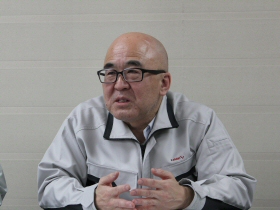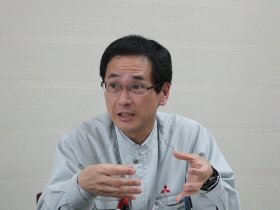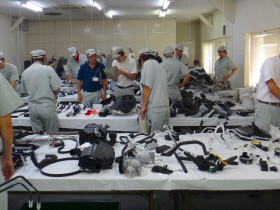Activities for Material Cost Reduction
This section introduces our activities for material cost reduction, a cost improvement initiative undertaken by NMKV in cooperation with Mitsubishi Motors and Nissan Motor. We held a talk session with Atsushi Tanaka who assumes the position of NMKV General Manager and is responsible for the entire activities, and Shigeru Ito (VFG1 Leader) and Kazuyoshi Ban (VFG2 Leader) from Mitsubishi and listened to their stories.

▲Ban, and Tanaka, and Ito (from left to right)
Material cost reduction to gain competitive strength
- To begin with, what kind of activity you partake in the material cost reduction?

Tanaka:The materials comprise raw material and components purchased from external suppliers, such as steel plates, paints, processed goods. The activities for material cost reduction aim to optimize the costs of aforementioned materials and to enhance potential of the merchandise. The spending for materials account for 70% of vehicle production costs. Pricing is one of the key factors in enhancing the competitive strength of vehicles we sell. Reducing the costs of materials is a critical challenge in the field of cost improvement for the purpose of pricing optimization.
- In the previous article we introduced TECO activities (click here to the article of TECO)So TECO is a part of the material cost reduction. Then, from what perspective do you try to improve the costs incurred?
Tanaka:Roughly, there are three approaches: commercial, technical and manufacturing. Firstly, a commercial approach means that we start a price negation with our suppliers. It’s not about simply negotiating price reductions. We take multiple quotations, conduct surveys on manufacturing lines of the materials, compare benchmarking results submitted by multiple suppliers, and finally evaluate the appropriateness of such pricing. We may extend such reviewing process not only the first-tier suppliers but also the second-tier suppliers. Secondly, a technical approach means to reduce costs by means of making technical modifications to an item. This is also known as Value
Engineering (VE). We re-scrutinize engineering drawings and specifications of the item and make appropriate modifications to eliminate the costs otherwise incurred.
Finally, a manufacturing approach means to reduce manufacturing costs at the site of suppliers. We request them for letting us visit the manufacturing lines of their plants. We will look for anything that can be improved but left untouched. We will propose them to improve. In cases where we find the rise in the defective rate because of excessive quality standards, we would propose them to review such standards to an appropriate quality level, thus achieving to reduce the costs. TECO activities which have been covered by your article encompass two approaches out of three: mainly technical and manufacturing approaches.
Activities of material cost reduction aim at variety of materials
- I think there are wide range of materials by these three approaches. Tell us how you work and explain your team structure and roles in the activities.
Tanaka:We have formed a multiple project groups to promote the activities, with VFG (Vehicle Function Group) taking the leading role. NMKV members, which are us, belong to VFG0 which is responsible for administration and facilitation over the entire activities. The actual activities of material cost reduction are undertaken by the groups from VFG1 to VFG6; as we split the automobile components into six different categories, which are bodies, interiors, electrical appliances, frames, engines, and drivetrains. These VFG are composed of Mitsubishi employees.
- I see. Tell us what each team does in more details. As Ito-san is the leader of VFG1, which means that your team is in charge of the material cost reduction for vehicle body components?

Ito:That’s correct. We are responsible for the following components: frames of sheet metal parts and their sub-components such as wiper motors, etc., exterior materials including bumpers, glass windows, etc., electrical appliances attached to bodies such as headlights, etc. There are a lot of parts and the involvement of suppliers is at a very high level. With each of those suppliers, one by one, every month, we hold a workshop named SWS (Supplier Workshop) aimed at the cost improvement, from which ideas for the material cost reduction are drawn out and then materialized on a fast pace. For example, think of a small component made of sheet metal parts. The sheet metal parts must be welded to a certain level at the supplier side, followed by an assembly process where other sub-components are assembled to make a finished item to be delivered to us the purchaser. In the case like this, we propose them an optimization of welding processes of such parts. As there are a large number of parts, components, and sub-components involved and our proposal tends to be a bold one which takes the matter to another level, I think our activities for material cost reduction are undertaken in a broad range of operations.
- Ban-san is the leader of VFG2. Tell us what kind of components and materials your group handle.
Ban: Interiors, interior decorating items, all components of car lining including seats, instrument panels, and airbags for passenger seats and side curtain airbags, etc. Although they are basically made of plastic, quite a lot of them have complex structure that comprise many sub-components. For example, the surface of an instrument panel is made of resin, which structure is reinforced by metal sheets and has several brackets and retainers for meters and audio devices to be attached later. In a case of such complex assembled component, we have to visit the assembly line at its supplier plant to confirm if there is any loss or inefficiency in the process. How many steps does a worker walk to fetch necessary components? How much time can you save if we swap a sequence of an assembling process? Answers to these questions may be trifle, but a small unit of improvement, when accumulated, can make a big improvement.
- So your task is to review the process to the minutest details. It seems that the number of components is vast and the range of covered specification is extensive. Doesn’t it require you to have ample experience and expertise in the field?
Tanaka:Maybe so. I think it’s true that many team members are of the older generation, all told.
Ban: Yes, the average age is on the older side.
“NMKV model” building a bridge between two companies
- The activities of material cost reduction have begun in the fiscal year 2013. We are at the end of second year of such activities. From what I guess from the look in your faces, you’re pretty much satisfied with the outcome of your work?
Ito:Yes. One of the achievements in my team is that we made a drastic change of the raw material used for car bumpers. Mitsubishi was the first company to develop bumpers made of resin. But as Mitsubishi had used the bumpers whose material was uniquely developed by itself, the competitiveness was rather weak from an aspect of price competitiveness. Therefore, we took a bold step to make a decision to switch the old material to a general-purpose material, which turned out be a success; we were able to increase the productivity and lower the pricing. In general, changing any material used in the course of manufacturing is very difficult. But in the end the result was outstanding which made all of us proud of what we achieved. Also, in the area of sheet metal parts, we were able to optimize the process of metal sheet cutting before pressworking. This was also a hard work. But the improvement has become an asset of knowledge because it can be applied not just for a single model but for all vehicle models in the future production. It was also one of the great outcomes.

Ban:An obvious example from my team is the elimination of plastic covers wrapped around seats’ headrests. It seemed easy to just stop using the cover. But a seat will undergo many processes until it actually reaches the hands of our customer: manufacturing, interim storage, transportation and delivery, assembling, and final transportation to a car dealer. We had to ensure that there was no contamination risk whatsoever in all processes hereabove. For this reason, we spent a month checking each of the process. We have requested for assistance from Nissan and its dealers through the facilitation of NMKV. It was confirmed, from the Nissan side as well, that there were no issues.
- A job well done. You can’t complete this type of activities without the assistance from the suppliers, not to mention the cooperation of NMKV, Nissan, and Mitsubishi, can you?
Ito:It’s really important to build a cooperative relationship with our suppliers. We had discussions with people from their manufacturing sides, not just people from sales sides. We proactively got involved in supporting to find solutions for inside affairs that each supplier had. These efforts helped us to enhance the relationship of trust with them.
Ban:A simple and straightforward approach like saying “let’s streamline workflow to reduce costs” did not work well. In many cases where we helped to improve the production lines, a better approach to obtain supplies’ understanding was to propose a set of new roles and operations for excess manpower, born from the streamlined workflow as the result of such improvement.
Tanaka:As explained in the article in TECO activities, the golden rule is that we and suppliers are to share the fruitful outcome on a fifty-fifty basis throughout such activities. It becomes just natural everyone raises a hand for a new proposal if he or she thinks it’s effective and worth trying. The great thing about this job is that all parties involved can share the outcome.
- It’s literally a win-win relationship. What kind of role and responsibility does NMKV take, as the leading entity in the position of supervising each of the team?

A scene of exhibition: components including competitors’ were laid out
on tables. Participants enjoyed free discussions over ideas for improvement.
Tanaka:It all comes down to this: to make the impossible possible. The direct communication between two parent companies makes things difficult, hard to achieve. NMKV builds a bridge between two companies, create a fusion, and makes it happen. As one of our major achievements in the fiscal year of 2014, we made a plan and held an event named “Joint Evaluation Conference for Appearance-Focused Ideas”. The evaluation team was composed of sales, product development and design, and product planning representatives both from Nissan and Mitsubishi in addition to NMKV executives. What we did was to present a car model which components of “appearance-focused” (both exterior and interior) were modified based on dozens of ideas created from a perspective of material cost reduction; and we urged them to evaluate the model. Although the actual evaluators were the decision-making representatives, it’s quite unlikely to be able to gather all those people to reach a conclusion in such a short period of time. At this event, many ideas were highly appreciated, and decisions were made to adopt some of them in the coming model. The ability to plan and hold this type of event where real decisions are made – I think this is exactly the significance of NMKV's existence.
- A surprising story indeed. Is there a lot more to it?
Tanaka:The outcome of recovered costs from the activities of material cost reduction can be used to strengthen our product lineup. By increasing the number of units sold, we can make good use of scale advantage and achieve further cost reduction. What we want to create is such virtuous cycle to win the war against our competitors in the Kei-car industry.
To this end, I believe it is essential to continue and improve the activities of material cost reduction. We stay focused to continue promoting such activities and hope to present the fruitful outcome at a 2015 version of “Joint Evaluation Conference for Appearance-Focused Ideas” event.
- Thank you for your time.
The talk session was held in March 2015. The positions they assume and affiliation they take in this article are as of at the time of the session.






